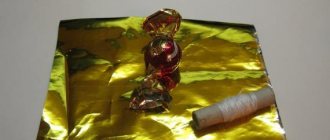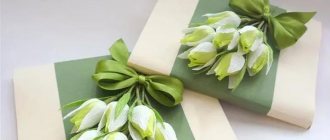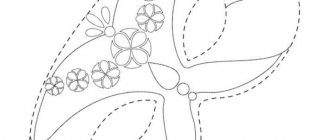How to make paper flowers?
To make paper flowers, first create small unopened gladiolus buds, which will be located at the top of the peduncle. Cut a wide strip of red corrugated paper. Fold it in half and carefully twist it in the center of the strip. You will get a bow like this.
Then we give the petals a convex shape and cut off the corners. Next, we connect the side parts of the workpiece.
Now you need to make green petals. To do this, take a piece of green crepe paper, fold it in half and twist the piece in the center.
Place a red bud inside the green blank and fix its lower part.
You need to prepare three such buds and one small one.
To create one gladiolus flower you will need four large petals. Cut out the required number of blanks.
Next, each petal needs to be given a natural shape by stretching it in the center.
We collect four petals together. We twist the lower part of the flower thoroughly.
We wrap the wire with green crepe paper.
Then we begin to attach the buds to the peduncle. We wrap crepe tape around the stem, gradually adding buds. First we attach the smallest, and then the largest flowers.
We cut out straight leaves from green paper and glue them to the bottom of the peduncle.
That's all, the paper gladioli flowers are ready.
Make a bouquet of gladioli branches of different shades and place them in a tall decorative vase. Such paper flowers will delight you with their spectacular beauty for a long time.
In today's master class we will tell you how to make a gladiolus out of paper.
To create such a craft you will need several materials and tools:
- crepe/corrugated paper in pink and green (to create flowers, it is advisable to use two shades, for example, pink and dark pink);
- double-sided green colored paper (for making leaves);
- small scissors;
- glue in stick;
- wire (we will use it for the base of the stem);
- pencil;
- thick paper or cardboard.
First, we will make blanks of buds (unblown and blossomed), and then we will attach them to a wire frame and decorate a gladiolus branch with several leaves.
Take a small sheet of cardboard, or any other thick paper, and draw the outline of the future petal. Then you need to carefully cut it along the contour line.
Use the resulting template to create the first gladiolus petal.
One gladiolus bud consists of six such parts. Having decided on the number of fluffed buds, make the required number of blanks.
Now the petal needs to be given a more natural and graceful shape. Fortunately, the elasticity of crepe or corrugated paper allows you to create the necessary, realistic bend and “ruffles” along the edge of the petal.
Do the same steps with the remaining petals.
Connect all six petals like this (you can use glue to be safe).
Cover the curled part of the bud with crepe/crimped paper tape.
All that remains is to straighten the petals and the first gladiolus bud is ready!
Make the required number of such blanks. For one branch you will need approximately 3-4 such buds; if desired, you can make more.
Now that we have completed the creation of large flowers, we can begin to create small, not yet blooming flowers. To do this, cut a small piece of crepe paper, fold it in half, twist it in the center and connect it at the bottom.
Do the same manipulations with the green strip, only before twisting the lower part, place the pink bud blank inside.
The first unopened bud is ready!
Make three or four more of the same blanks.
Then we add larger (opened) buds.
Treat the wire with green tape until the very end, and secure the tape with glue. The gladiolus branch is ready, all that remains is to attach a few leaves.
We cut out the following leaves from colored double-sided paper.
We give them a more natural texture by making several longitudinal stripes with the back of the pencil.
Then we apply a little glue to the bottom of the leaf and glue them to the stem.
Now the gladiolus branch is ready!
Elena Kashirskaya (Drozd)
Master class: Bouquet of sweets “GLADIOLIS”
It’s summer now, but autumn is just around the corner, or rather September 1st... I remember during my childhood (I lived in a small town) in every garden by September gladioli were blooming and we local kids brought these flowers to the teacher on the first bell at school - GLADIOLUS . Somehow nostalgia struck and I decided to dispel it... I went online, found photographs of these simple flowers and decided to make a bouquet of gladioli in their likeness using candy. Such a sweet bouquet...
For work I needed:
floral crepe (corrugated) paper, colors:
- pink
- light lilac
- lilac
- green
candies – 9 pcs.,
hot glue,
tape tape,
wooden kebab skewers (toothpicks or wire),
scissors ,
tape or thread.
I’m starting to make gladioli from candies:
1.
To make buds, cut out strips of paper 1 cm wide along the entire length of the sheet.
Cut the strip into 4 equal parts. For one gladiolus you will need 8 parts of green paper and 4 parts of colored paper. Accordingly, for the buds of three gladioli we will need: 6 stripes of green and 1 strip of each color. 2.
We twist each strip in the middle and bend it in half (as for crocuses), stretch it in the middle and bend it.
For the top bud, we fasten one strip into the bud with a thread, for the next two, 2 strips of green color, crossing them crosswise. 3.
For the next four buds you will need 1 strip of colored paper and 1 strip of green paper (for each bud).
Two buds so that the colored part is inside, and two buds so that the colored part is on top. We secure each bud with thread. 4.
Attach the buds one by one in a checkerboard pattern to the skewer and wrap the tape with tape (it can be replaced with green corrugated paper).
5.
This is what it should look like.
6.
To make the flowers themselves, cut out 3 strips 3-4 cm wide of each color.
We cut each strip into 6 parts, it can be equal, but I cut 3 smaller parts and 3 larger parts. I cut out petals from the strips, this is the shape. I twist each petal with scissors and stretch the middle. I stretch the edges of the petal to create a beautiful wave. 7.
Then I screw three petals to the candy with thread or wire, and then three more between the already screwed petals.
8.
These are the gladiolus flowers you get.
9.
For each gladiolus we make three flowers. Of course, you can do more, but I did three.
10.
We attach green leaves to the back of the flower. Like this.
11.
Then I sequentially attach the flower to the skewer with thermal glue, wrapping the tape with tape.
When the skewer runs out, I extend it with another, twisting them together. In places where the flower is, the stem becomes denser and therefore the growth is not noticeable. I also attach gladioli leaves cut out from corrugated paper. 12.
These are the cute gladioli you get.
13.
Together they look like this.
14.
Putting everything together.
15. The bouquet can be packed or arranged into a composition. I made it a bouquet.
So turn on your imagination and create.
Master class: “Noble handsome man - gladiolus”
Master class: “Handsome noble - gladiolus”
What does gladiolus mean and who is it given to?
The plant was brought to Europe from southern Africa. Translated from Latin, gladiolus means “sword”. The following meanings were attributed to the flower:
- bravery;
- courage;
- Love.
Ancient Warriors believed that if they attached the bud to their clothes, the gladiolus would protect them from death.
From modern symbolism - gladiolus:
- the beginning of a new stage;
- respect for the one to whom it is presented.
Thanks to the variety of bud shapes and colors, bouquets of gladioli are equally appropriate for both women and the stronger half of humanity.
What forms of bouquets and design style are most advantageous for gladioli?
The symmetrical technique of assembling gladioli is not encouraged by florists - the bouquet looks unnatural. A good solution is the free arrangement of all elements. This technique is called asymmetrical. The technology is complex and requires certain skills.
Gladioli are placed in the center - they are the basis of the composition, and at the same time they form one whole with other plants. The present looks natural and relaxed.
The cascade form allows you to see all the beauty of the flower - each specimen is laid according to a descending principle. As a rule, gladioli occupy the background and form a longitudinal dominant. Additional volume to the composition is given by low-growing plants that have voluminous, lush clusters of flowers.
What plants, including flowers, does gladiolus go well with? Undesirable combinations
Gladiolus is a complex flower in terms of floristry, since it does not tolerate proximity to every plant. Particular care must be taken when arranging multi-faceted bouquets. Against the background of ferns and other decorative greenery, gladioli look very impressive.
Their bouquet partners will be:
- chrysanthemums;
- dahlias;
- roses and eustomas;
- orchids;
- lilies.
Take into account the height of the stems and mix them with equally tall “neighbors”.
Antagonist plants:
- lily of the valley;
- most wildflowers;
- tulip.











